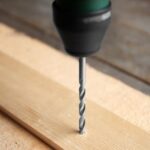Dealing with a stain that didn’t dry properly on kitchen woodwork can be extremely frustrating. The unsightly appearance and tacky texture can diminish the overall beauty of the wood and leave homeowners wondering if there’s anything they can do to salvage the situation.
Properly drying stain is crucial for achieving a flawless finish that enhances the aesthetics of your kitchen. In this article, we will explore the reasons behind improper stain drying on kitchen woodwork, discuss potential solutions, and provide a step-by-step guide to sanding the stain for those looking to fix this issue.
There could be various factors that contribute to improper stain drying on kitchen woodwork. Whether it’s improper application techniques or unfavorable environmental conditions, understanding these reasons can help prevent future staining mishaps. Additionally, we will delve into common mistakes people make during the staining process and provide helpful tips to avoid them.
Fortunately, there is hope for those facing the issue of improperly dried stain on their kitchen woodwork. Sanding is one option that can effectively remove the unsightly stain and allow you to start fresh.
We will discuss the importance of sanding as a solution rather than resorting to more extreme measures like stripping or replacing the woodwork altogether. Furthermore, we will provide a step-by-step guide to help you navigate through the sanding process, including necessary equipment and precautions for achieving optimal results.
Understanding the reasons behind improper stain drying on kitchen woodwork
When dealing with improperly dried stain on kitchen woodwork, it’s important to understand the reasons behind this issue in order to effectively address and fix it. There are several potential factors that may have led to the stain not drying properly, as well as common mistakes people make during the staining process.
One possible reason for improper stain drying is inadequate ventilation. Lack of proper airflow can prevent the stain from drying completely. This can happen when working in enclosed spaces or during humid weather conditions. Another factor could be applying too thick of a layer of stain. When a thick layer is applied, it takes longer for the solvent to evaporate, resulting in a slower drying time.
In addition, using the wrong type of stain for the specific woodwork can also lead to problems with drying. Some stains are formulated for specific wood types and may not adhere or dry properly if used on different surfaces. It’s important to choose a stain that is suitable for the particular woodwork being stained.
Common mistakes people make during the staining process can also contribute to improper drying. These include not properly preparing the surface before staining, such as failing to remove old finishes or sanding unevenly. Inadequate mixing of stains or applying multiple coats too quickly can also affect how well the stain dries.
To avoid these issues and ensure proper stain drying on kitchen woodwork, it’s crucial to follow instructions carefully and take necessary precautions such as ensuring proper ventilation, applying thin layers of stain, using appropriate products for the specific woodwork, and allowing sufficient drying time between coats.
Understanding these reasons behind improper stain drying will help in identifying and addressing any issues that may arise during the staining process. By avoiding common mistakes and following best practices, you can achieve a beautiful finish on your kitchen woodwork without any issues with drying.
Can you salvage stain that didn’t dry on kitchen woodwork?
If you find yourself with a stain that didn’t dry properly on your kitchen woodwork, don’t panic. There are several options available to salvage the situation and achieve the beautiful finish you desire. Sanding is one of the most effective methods for fixing stain that didn’t dry properly.
The Importance of Sanding
Sanding is an essential step in fixing a stain that didn’t dry on kitchen woodwork. This process helps to remove the improperly dried stain and prepares the surface for a fresh application. By sanding the stained area, you can effectively eliminate any unevenness or blotchiness caused by the improperly dried stain.
One advantage of sanding as a solution is that it provides an opportunity to correct any mistakes or imperfections from the previous staining attempt. Sanding allows you to smooth out rough spots, remove excess stain, and create a clean canvas for reapplication. It also enables better adhesion of subsequent layers of stain.
Step-by-step Guide to Sanding Stain
Before embarking on this process, gather all necessary equipment such as sandpaper (medium to fine grit), a sanding block or pad, and safety goggles. It’s important to protect your eyes from dust particles during sanding.
Begin by carefully sanding the affected area using light pressure and back-and-forth motions. Work gradually, checking frequently to ensure you are not over-sanding or damaging the wood surface beneath the stain. As you progress, switch to finer grit sandpaper for a smoother finish.
Once you’ve adequately sanded away the improperly dried stain, use a clean cloth or vacuum cleaner to remove any dust particles left behind. At this point, your kitchen woodwork is ready for reapplication of fresh stain following proper techniques and guidelines.
By following these steps and exercising patience and care while sanding, you can salvage stain that didn’t dry properly on your kitchen woodwork and restore it to its intended beauty. Remember to allow the newly applied stain to dry properly, per the manufacturer’s instructions, for a flawless finish.
The importance of sanding in fixing stain that didn’t dry on kitchen woodwork
When faced with the issue of stain that didn’t dry properly on kitchen woodwork, one of the most effective solutions is sanding. Sanding plays a crucial role in fixing improperly dried stain and can restore the woodwork to its intended appearance. Whether it’s due to excessive humidity, using the wrong type of stain, or simply an error in application, sanding can help remove the problem area and provide a clean slate for re-staining.
Sanding serves as a key step in the process of fixing stained woodwork because it helps remove the layer of improperly dried stain. By sanding the affected area, you can smooth out any rough patches or inconsistencies caused by the unsuccessful drying process. This not only improves the overall aesthetics of the woodwork but also prepares it for better adhesion when reapplying the stain.
Another important factor to consider is that sanding provides a less drastic solution compared to other options that may involve harsh chemicals or stripping methods. Instead of resorting to extreme measures that could potentially damage the wood or require extensive renovation, sanding allows for a simpler and more precise fix. It levels out the surface and removes only what needs to be removed, ensuring minimal disruption to the surrounding woodwork.
However, it is crucial to approach sanding with caution and follow a proper procedure. Begin by gathering all necessary equipment such as various grits of sandpaper, sanding blocks or sanders, and protective gear like safety glasses and masks. Start by using coarse-grit sandpaper until all remnants of the improperly dried stain are removed, then gradually move on to finer grits for a smoother finish. Take your time and pay attention to detail during this process to achieve optimal results.
Sanding offers individuals facing improperly dried stain on their kitchen woodwork an effective way to salvage their surfaces without going through complicated or invasive methods. By carefully following proper procedures and taking necessary precautions, anyone can successfully fix their stained woodwork and achieve the desired finish.
Step-by-step guide to sanding stain that didn’t dry on kitchen woodwork
One of the options for salvaging stain that didn’t dry properly on kitchen woodwork is to sand it. Sanding can help remove the improperly dried stain and provide a fresh surface for reapplication. Here is a step-by-step guide to sanding stain that didn’t dry on kitchen woodwork:
Equipment needed
- Sandpaper (medium-grit and fine-grit).
- Sanding block or electric sander.
- Safety glasses or goggles.
- Dust mask or respirator.
- Drop cloth or plastic sheeting.
- Clean cloth or tack cloth.
Procedure
- Prepare your workspace by laying down a drop cloth or plastic sheeting to protect your kitchen surfaces from dust and debris.
- Put on safety glasses or goggles to protect your eyes, and a dust mask or respirator to prevent inhalation of dust particles.
- Use medium-grit sandpaper attached to a sanding block or electric sander to start sanding the stained woodwork. Move the sandpaper in the direction of the wood grain, applying even pressure.
- Continue sanding until you have removed most of the improperly dried stain. Be careful not to over-sand and damage the woodwork.
- Switch to fine-grit sandpaper and repeat the sanding process, this time focusing on smoothing out any remaining rough areas from the previous step.
- Once you are satisfied with the results, wipe down the sanded woodwork with a clean cloth or tack cloth to remove any dust particles.
It is important to note that after sanding, you will need to reapply stain to achieve a consistent finish. Make sure to follow proper staining techniques and allow sufficient drying time as per manufacturer instructions.
By following these steps, you can effectively remove improperly dried stain from kitchen woodwork through sanding and pave the way for reapplication of stain for achieving a beautiful finish.
Tips for reapplying stain after sanding
After sanding the improperly dried stain on your kitchen woodwork, it’s time to consider reapplying a fresh coat of stain. This section will provide you with some helpful tips and techniques for achieving a beautiful and even finish on your woodwork.
1. Selecting the right stain:
When choosing a new stain, it’s important to consider the color and type of wood you’re working with. Different woods absorb stains differently, so it’s a good idea to test the stain on a small area first to ensure that you achieve the desired color.
Take into account the existing color of your woodwork and choose a stain shade accordingly. Additionally, make sure to use an oil-based or gel-based stain that is compatible with your project.
2. Applying the stain evenly:
Before applying the new coat of stain, prepare your wood surface by removing any dust or residue from sanding. Stir your chosen stain thoroughly to ensure an even distribution of pigments throughout the can. When applying the stain, use a clean brush, rag, or sponge applicator in long, even strokes along the grain of the wood. Avoid going over areas that have already been stained as this can result in uneven coloring.
3. Allowing proper drying time:
Once you have applied the new coat of stain, it is crucial to allow it ample time to dry properly before applying any other finishes or sealants. Follow the manufacturer’s instructions on drying times, but typically leave it undisturbed for at least 24 hours before moving on to other steps in your refinishing process.
By following these tips for reapplying stain after sanding, you can achieve an attractive and uniform finish on your kitchen woodwork. Remember to take your time and be patient throughout each step of the process. Properly dried and beautifully stained woodwork will enhance the overall look and feel of your kitchen space.
| Tip | Description |
|---|---|
| Selecting the right stain | Consider color and wood type, test stain on a small area, choose compatible oil-based or gel-based stain |
| Applying the stain evenly | Prepare wood surface, stir stain thoroughly, use even strokes along the grain of the wood, avoid overlapping stained areas |
| Allowing proper drying time | Follow manufacturer’s instructions for drying times, leave undisturbed for at least 24 hours before proceeding with other steps |
Alternative options for fixing stain that didn’t dry on kitchen woodwork
While sanding is often the go-to solution for fixing stain that didn’t dry properly on kitchen woodwork, there are alternative options available for those who prefer not to use this method. These alternatives may require less effort and time, but it’s important to keep in mind that their effectiveness can vary depending on the specific situation and the type of stain used.
- Chemical Stripping: One alternative option for removing improperly dried stain is using a chemical stripping agent. These products work by breaking down the stain at a molecular level, making it easier to remove from the wood surface.
It’s crucial to choose a chemical stripper that is safe for indoor use and suitable for your specific type of woodwork. Before applying the stripper, make sure to follow all safety precautions provided by the manufacturer, such as wearing protective gloves and working in a well-ventilated area. - Heat Gun: Another method for removing dried-on stain is using a heat gun. This tool produces high temperatures that can soften and loosen the stain from the wood surface, allowing you to scrape it off with a putty knife or similar tool.
It’s important to exercise caution when using a heat gun, as excessive heat can scorch or damage the wood. Start by setting the heat gun at a low temperature and gradually increase if necessary. - Re-staining: If you’re not keen on removing the improperly dried stain completely, re-staining over it may be an option worth considering. Before doing so, lightly sand the stained woodwork to create a smooth surface for better adhesion of the new stain. Ensure any loose particles or debris are removed before applying a thin layer of new stain evenly over the previous one.
It’s crucial to note that these alternative options may not always yield satisfactory results compared to sanding off the old stain and starting fresh. Additionally, some stains may be more challenging to remove using alternatives. Therefore, it’s essential to weigh the pros and cons of each method and consider the condition of your woodwork before deciding on an alternative solution.
| Alternative Options | Description |
|---|---|
| Chemical Stripping | A method that involves using a chemical stripper to break down the improperly dried stain |
| Heat Gun | A technique that utilizes high temperatures from a heat gun to soften and scrape off the dried-on stain |
| Re-staining | Applying a new layer of stain over the improperly dried stain after lightly sanding the surface |
Preventing future staining issues on kitchen woodwork
Properly staining and finishing kitchen woodwork is essential for achieving a beautiful and durable finish. By taking the appropriate precautions and following the right techniques, you can prevent future staining issues on your kitchen woodwork. Here are some tips and best practices to help you achieve flawless results:
- Choose the right stain: Before starting the staining process, make sure to select a stain that is suitable for your kitchen woodwork. Consider factors such as the type of wood, desired color, and level of protection needed. It’s important to choose a stain that is specifically designed for interior use and compatible with the type of wood you are working with.
- Prepare the surface properly: Proper surface preparation is crucial for ensuring even stain adhesion and drying. Start by thoroughly cleaning the woodwork to remove any dirt, grease, or previous finishes. Use sandpaper or a sanding block to smooth out any imperfections or rough surfaces. Be sure to remove all dust before applying the stain.
- Apply stain in consistent coats: When applying the stain, it’s important to do so in consistent and even coats. Avoid applying too much stain at once, as this can lead to uneven drying and potential issues with adhesion. Instead, apply thin coats of stain using a brush or rag, following the grain of the wood.
- Allow proper drying time: Once you have applied the stain, make sure to allow sufficient drying time between coats and before using or handling the stained woodwork. Follow manufacturer instructions for recommended drying times. Avoid rushing the process or exposing freshly stained surfaces to excessive heat or moisture.
- Use a protective finish: To further enhance durability and protect your kitchen woodwork from stains, scratches, and moisture damage, consider applying a protective finish over the stained surface. Polyurethane or varnish are popular options that provide excellent protection and enhance the natural beauty of the wood.
By following these tips and techniques, you can prevent future staining issues on your kitchen woodwork and achieve a flawless finish that will stand the test of time. Remember to always read and follow the instructions provided by stain and finish manufacturers for best results. With proper care and maintenance, your kitchen woodwork will remain beautiful and durable for years to come.
Conclusion
In conclusion, dealing with improperly dried stain on kitchen woodwork can be a frustrating situation. It is important to understand the reasons behind this issue, including potential factors that may have led to the stain not drying properly and common mistakes made during the staining process. However, there is hope and solutions available for individuals facing this problem.
One possible solution for salvaging stain that didn’t dry on kitchen woodwork is sanding. Sanding can help remove the improperly dried stain and provide a fresh surface for reapplication. It is a less extreme measure compared to other alternatives and offers several benefits in achieving a beautiful finish.
To effectively sand the stained woodwork, it is important to gather the necessary equipment and follow a step-by-step guide. This includes selecting the right equipment for sanding and following a detailed procedure that ensures even sanding and best possible results. Additionally, precautions and tips should be followed to avoid any damage or mishaps during the process.
For those who prefer not to sand their stained woodwork, alternative options are available. However, it is important to consider potential outcomes and drawbacks before deciding on an alternative solution.
Frequently Asked Questions
How do you remove tacky stains from a deck?
To remove tacky stains from a deck, there are a few steps you can follow. First, you should sweep or blow off any loose dirt, leaves, or debris from the deck surface. Then, use a gentle detergent mixed with water to clean the stained areas.
Scrub the stains lightly using a soft-bristle brush or nylon pad to avoid damaging the wood. Rinse off the detergent thoroughly with clean water and allow the deck to dry completely before applying any further treatments or sealants. If the stains persist, you may need to resort to using specialized deck cleaners or stain removers specifically designed for outdoor wooden surfaces.
How do you remove tacky stains from wood?
Removing tacky stains from wood requires some care to protect the finish and minimize damage to the surface. Begin by gently wiping away any excess stain using a cloth or paper towel. Next, prepare a mixture of mild dish soap and warm water and use a cloth dampened with this solution to gently scrub the stained area in circular motions.
Avoid soaking the wood with excessive moisture as this can lead to warping or discoloration. Rinse off any soap residue thoroughly and allow the wood to dry naturally. To restore shine and further protect the wood, consider applying an appropriate furniture polish or wood conditioner.
How do you fix a bad stain job?
Fixing a bad stain job largely depends on identifying what went wrong in order to correct it properly. Start by assessing if it’s possible to simply sand down the overly darkened area without affecting adjacent sections too much. If that’s not an option, you might need to strip off all existing stain from that particular area before restaining it correctly.
The stripping process generally involves using chemical strippers followed by thorough sanding of the bare wood surface until smooth and consistent in color tone with surrounding areas if needed. Afterward, apply fresh stain following proper techniques such as even application and wiping away excess immediately for better results. It’s crucial to test stains on inconspicuous areas first and use compatible products for a successful refinishing job.

Hi everyone! I’m a woodworker and blogger, and this is my woodworking blog. In my blog, I share tips and tricks for woodworkers of all skill levels, as well as project ideas that you can try yourself.





